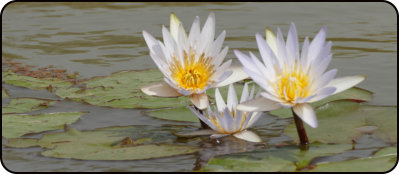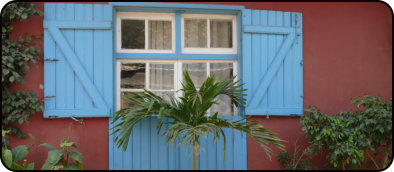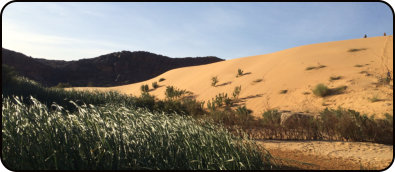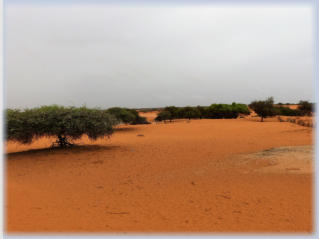


Senegal/Mauritania: Wonders of the Desert
Are you curious about nomadic culture and life in sand dunes? Then join us on a tour to the north of Senegal and to the touristically
undiscovered Mauritania. While Senegal is a Sahel-influenced country, Mauritania offers an impressive geographical and cultural
transition from Arab Africa to the sub-Saharan part of the continent. En route, there are fascinating scenic gems such as the colourful
Lac Rose, lush oases with green palm groves, well-preserved rock paintings and breathtaking desert landscapes. Animal and bird
watching in the Bandia Reserve and Djoudj National Park, historical sites such as Ile de Gorée, Saint Louis, Chinguetti and Ouadane
as well as the archaeological excavations in Azougui make our tour an unforgettable experience.
Day 1: Arrival at Dakar
Meet and greet with your tour leader at the new Blaise Diagne Airport
and transfer to the hotel (approx. 70 km)
(-/-), overnight in Dakar, Hotel Sokhamon or similar
Day 2: Dakar: excursion to the Island of Gorée After this morning's welcome meeting, we'll spend the morning exploring Dakar, Senegal‘s vibrant capital. Dakar was founded in 1857 by the French as a military post on the lands of the Lebou community. Due to its fast development it became the capital of French West Africa in 1902. Today the city has more than two million inhabitants. This morning we‘ll drive to the Monument de la Renaissance Africaine, a 49- metre-high bronze statue commissioned by former Senegalese President Abdoulaye Wade. We‘ll climb up the stairs to the foot of the statue, where in clear weather you‘ll have a magnificent view of the city. Later we’ll explore the center of Dakar visiting the I.F.A.N. Museum, the Cathedral and the craft market „Village Artisanal“ in Soumbédioune. We‘ll stroll through Kermel Market, which is well-known for the women who sell flowers there, and over Independence Square before driving to the ferry terminal to take a ferry to Isle de Goree. The ferry crossing takes around 20 minutes. The Europeans were the first to settle in the 15th century. We’ll take a walking tour across the island which was a center of the Atlantic slave trade for 300 years. In the Slave house, “Maison d’Esclaves” we’ll see the „Door of no return“. On our walk we’ll also discover the church of St. Charles Boramee, the Historical Museum of Senegal and many other interesting sites. The island was designated a UNESCO World Heritage Site in 1978. Back to the mainland you will continue your journey to the Pink Lake. (approx. 40 km) (B/D), overnight at the Pink Lake, Hotel Palal or Trarza or similar Day 3: Pink Lake: excursion to Bandia This morning you‘ll go on an exciting game drive in search of different animals such as monkeys, gazelles, giraffes, antelopes and rhinos. The German forester Christian Dehring founded the park in 1997 with the aim of restoring the original savannah landscape. Some animal species were imported from South Africa such as impalas, zebras, ostriches, and giraffes. This afternoon, you‘ll return to the Pink Lake, also known as Lake Retba. The Lac Rose has got its name because of its unique pink colour, which is particularly visible in the dry season, depending on the sun's rays and wind conditions, which are particularly visible in the dry season. The lake is very salty, comparable to the Dead Sea and it is internationally well-known for the Paris-Dakar Rally, as here was the finishing line. In the afternoon you can observe the salt mining. (approx. 80 km) (B/D), overnight at the Pink Lake, Hotel Palal or Trarza or similar Day 4: Pink Lake - Saint-Louis Today we continue north to Saint-Louis, former capital of the French colony of „Afrique occidentale française“ and considered by many as the jewel of West Africa. Despite population growth to estimated 175.000 inhabitants Saint-Louis has retained its charme. This afternoon we will explore the beautiful old town with its well-preserved and restored colonial buildings by a typical horse-drawn carriage. The old quarters on the Island of Saint-Louis at the mouth of the Senegal River were inscribed a UNESCO World Heritage site in 2000. We’ll also discover the thriving fishing community of Guet N’Dar situated on the Langue de Barbarie peninsula. Since 2000, the old town on The Ile St- Louis has been a UNESCO World Heritage Site. (approx. 200 km). (B/D), overnight in St. Louis, Hotel Mermoz or similar Day 5: Saint-Louis: Excursion to Djoudj NP The Senegal River flows into the sea in a large delta near St. Louis. In this delta, approx. 60 km from Saint-Louis, lies the third largest bird reserve in the world, the Djoudj National Park, added to the List of World Heritage in Danger in 2000. In the morning we take a boat ride of several hours through this natural paradise. You can observe and photograph the numerous bird species, including many rare ones. After the visit we‘ll return to Saint-Louis. This afternoon is free at your leisure: you can relax on the beautiful sandy beach in front of your hotel or take a stroll through the city. (approx. 140 km). (B/D), overnight in St. Louis, Hotel Mermoz or similar Day 6: Saint-Louis - Nouakchott Today you leave Senegal and cross into Mauritania. Border formalities. On the way to Nouakchott you will pass through small beautiful villages with colourful houses and mosques. From time to time you will meet typical Moorish nomadic tents and large herds of camel. In the late afternoon you reach the capital city of Mauritania. Grenzformalitäten. Every now and then you will encounter typical Moorish nomad tents and large herds of camels. In the late afternoon you reach the capital of Mauritania. (approx. 310 km) (B/D), overnight in Nouakchott, Auberge K or similar Day 7: Nouakchott - Amojar Canyon - Chinguetti This morning we begin our journey to Chinguetti. We'll drive for around 5 hours to Atar. Here your guide will buy provisions for the picnic. After another 30 minutes you will reach the picturesque Amogjar Canyon, where you will have your picnic lunch in a beautiful setting. This afternoon you‘ll visit prehistoric rock paintings, depicting giraffes and other animals from times when there were green savannah landscapes where there is desert today. We then continue our trip to Chinguetti, one of the seven holy cities of Islam (approx. one hour‘s drive). Enjoy the sunset on a dune outside the city gates with a magnificent view of the old quarters of Chinguetti. (B/P/D), overnight at a guesthouse
Day 8: Chinguetti: excursion to the oasis Kemkemt
Chinguetti is a
small city with an
important past. It
was founded in the
11th century by
Berbers. The old
city is
characterized by
mud and stone
constructions with
patios, which are
grouped around
the mosques.
Chinguetti was
long a famous seat
of Islamic learning
and has a library
with manuscripts of
inestimable value.
During our tour of
the old town you can
take a look at old manuscripts. Later today you‘ll visit a clay pit, which
once provided the basic material for the construction of the city. The
well-preserved ruins of the trading post (Arabic Ksar) have been a
UNESCO World Heritage Site since 1996. In the late morning you drive
to the oasis Kemkemt, which is located about 5 km outside the city.
Here you have your picnic under date palmtrees and spend a leisurely
afternoon. After the heat of midday has died down, there is the
possibility of a camel ride through the wadi. In the evening you return to
Chinguetti.
(B/P/D), overnight at a guesthouse
Day 9: Chinguetti - Ouadane
This morning we will depart Chinguetti to begin our journey to the
ancient town of Ouadane. Our drive hrough beautiful sand dunes will
take 2 to 3 hours. On the way, you will be the guest of nomads in the
Tenochert oasis, who will welcome you with a tea ritual typical of the
area. Around noon you will reach Ouadane. Lunch at the guesthouse.
This afternoon you visit the old city and the city walls. Founded by
Berbers in the 12th century, the city has long been an important trading
hub for gold, dates, and salt. Like Chingetti, the well-preserved ruins of
the trading post have been a UNESCO World Heritage Site since 1996.
Ouadane also contains valuable old manuscripts in predominantly
private libraries. In the evening you will experience an unforgettable
sunset over the old town and then drive back to your guesthouse.
(B/P/D), overnight at a guesthouse
Day 10: Ouadane - Terjit
After breakfast you will drive to the Terjit Oasis with its hot and cold
springs. On the way there you will pass through the largest oasis in the
Adrar region, Mheirith. Depending on the season, there are also natural
pools here where you can swim until our chef has prepared lunch. After
a refreshing swim, you will have a packed lunch in the shade of lush
date palms. Another three hours‘ drive will bring us to Terjit via the town
of Aodjaft and the beautiful oasis of Toungad. You cross a sea of sand
to reach the fantastic viewpoint of Tivoujar. Enjoy a rest under an
impressive acacia tree! Then continue your journey through the
breathtaking desert and mountain landscapes towards Terjit. a
wonderful place framed by a magnificent environment.
(B/P/D), overnight at Gamal‘s campsite in Terjit
Day 11: Terjit - Atar - Azougui - Ben Amira
This morning, you will visit the natural springs of Terjit. A hot and a cold
spring rise from the rock here and fill the natural swimming pool with
pleasantly temperate water. This is where the city dwellers of Atar and
Nouakchott like to relax at the weekend. Along the way today we will
visit the archaeological excavations of Azougui, the ancient capital of
the Almoravids at the gates of Atar. It was from here that they began
their conquests in the 11th century, which stretched from Ghana to
Spain. After the visit, we continue our journey for around 3 hours to Ben
Amira. Near this small village stands the second largest monolith in the
world. We pitch our tents at the foot of the impressive rock.
(B/P/D), overnight in a tent
Day 12: Ben Amira - Nouadhibou
After breakfast, a special sight awaits you. You will see the longest train
in the world. The train, over 2 km long, transports iron ore, people and
animals over 700 km to the port of Nouadhibou. Every day there are
several trains going to the port or are on their way back, but only in
three places on the route is there more than one track so they can pass
each other. Our journey along the tracks is exciting. Only 90 km before
Nouadhibou we reach the tarred road. (approx. 7 hours‘ drive).
(F/P/A) overnight in Nouadhibou, Hotel Aljazira oder ähnlich
Day 13: Nouadhibou - Nouakchott
The city of Nouadhibou, situated on a peninsula, is Mauritania's largest
port and the country's economic centre. In the morning, a short
excursion to the sea awaits you. At the picturesquely situated Cap Blanc
you can observe numerous birds and with a bit of luck you will see the
rare monk seals. Afterwards, you will drive back to Nouakchott on a
good tarred road. (approx. 6 hours‘ drive).
(B/P/D), overnight in Nouakchott, Auberge K or similar
Day 14: Nouakchott - End of tour
This morning, you will visit Nouakchott, an urban refugee camp of
settled nomads, a settlement without a historic city centre. You will gain
an insight into all aspects of cultural change in the country during a visit
to the National Museum. You will also visit the central market and the
picturesque fishing port "Port de Peche". (approx. 10 km).
(B), day use rooms
Please note that from time to time our itineraries may be amended.




•
Dakar and Nouakchott: two contrasting
capitals
•
Ile de Gorée: History of slavery
•
Pink Lake: Fantastic play of colours
•
Bandia: In search of rhinos
•
St. Louis: The Pearl of West Africa
•
Djoudj: Bird paradise in the delta of the
Senegal River
•
Chinguetti and Ouadane: UNESCO World
Heritage Site made of clay
•
Kemkemt, Mheirith, Terjit: Magnificent
•
oases in a sea of sand
•
Azougui: Ruins of the Almoravids
•
Adrar Region: fascinating desert
landscapes
•
Longest Train in the World









Tour Highlights:


Vero Tours






















